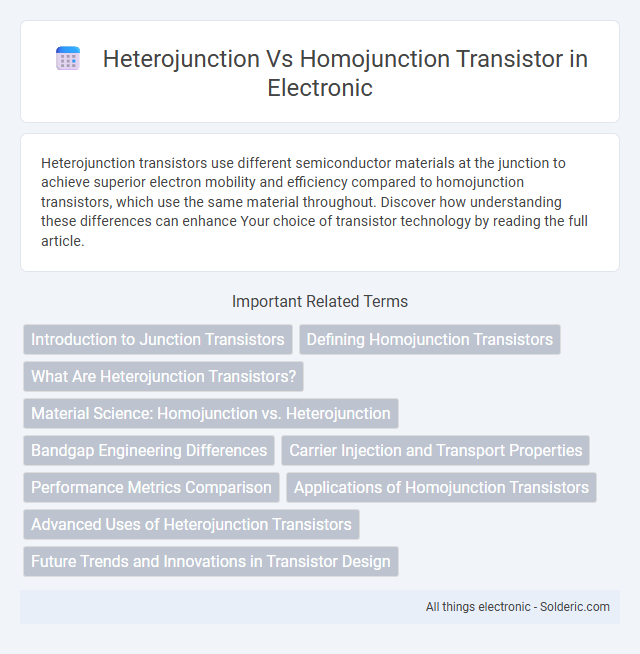Heterojunction transistors use different semiconductor materials at the junction to achieve superior electron mobility and efficiency compared to homojunction transistors, which use the same material throughout. Discover how understanding these differences can enhance Your choice of transistor technology by reading the full article.
Comparison Table
| Feature | Heterojunction Transistor | Homojunction Transistor |
|---|---|---|
| Material Composition | Different semiconductor materials (e.g., GaAs/AlGaAs) | Same semiconductor material (e.g., Silicon) |
| Bandgap | Discontinuous bandgap at junction | Continuous bandgap at junction |
| Carrier Injection Efficiency | Higher due to bandgap engineering | Lower, limited by same material properties |
| Electron Mobility | Higher mobility, faster switching | Lower mobility, slower operation |
| Performance | High-speed, low noise, high-frequency | Moderate speed, higher noise |
| Applications | RF amplifiers, high-speed circuits, optoelectronics | General purpose amplifiers, switching circuits |
| Fabrication Complexity | More complex due to multiple materials | Simpler, single material process |
| Thermal Stability | Generally lower due to lattice mismatch | Higher thermal robustness |
Introduction to Junction Transistors
Junction transistors are semiconductor devices that use junctions to control current flow, with homojunction transistors consisting of p-n junctions formed from the same semiconductor material, typically silicon. Heterojunction transistors, on the other hand, feature junctions between different semiconductor materials with varying band gaps, enhancing performance by improving charge carrier injection and reducing recombination losses. Understanding the distinct material properties of heterojunction versus homojunction transistors helps optimize your electronic circuits for higher speed and efficiency.
Defining Homojunction Transistors
Homojunction transistors consist of semiconductor materials with uniform bandgap properties throughout the device, typically silicon in bipolar junction transistors (BJTs) or field-effect transistors (FETs). Their operation relies on charge carrier injection across a single kind of material interface, resulting in characteristic current-voltage behavior and well-understood switching speeds. Homojunction devices are often contrasted with heterojunction transistors, which use differing semiconductor materials to achieve enhanced performance such as higher electron mobility and improved frequency response.
What Are Heterojunction Transistors?
Heterojunction transistors utilize junctions formed between different semiconductor materials with varying band gaps, enhancing electron mobility and reducing recombination rates compared to homojunction transistors made from a single semiconductor material. This material disparity creates superior charge carrier confinement and improved injection efficiency, leading to higher frequency performance and increased gain in applications like high-speed amplifiers and optoelectronics. The band alignment and interface quality in heterojunction devices are critical factors that distinguish their electrical characteristics and overall efficiency from conventional homojunction transistors.
Material Science: Homojunction vs. Heterojunction
Homojunction transistors utilize a single semiconductor material with uniform bandgap properties, typically silicon, resulting in simpler fabrication but limited performance in high-speed or high-frequency applications. Heterojunction transistors incorporate two or more semiconductor materials with differing bandgaps, such as gallium arsenide and aluminum gallium arsenide, enabling enhanced electron mobility and improved carrier confinement. This material heterogeneity in heterojunctions allows for superior efficiency, faster switching speeds, and better thermal stability compared to homojunction counterparts.
Bandgap Engineering Differences
Heterojunction transistors utilize bandgap engineering by combining materials with different bandgaps, creating interface regions that enhance electron mobility and reduce recombination rates, thereby improving device performance. Homojunction transistors, in contrast, are constructed from a single semiconductor material with uniform bandgap, leading to less efficient charge carrier control and lower speed. The distinct band alignment in heterojunctions enables superior electronic properties like higher cutoff frequencies and better thermal stability.
Carrier Injection and Transport Properties
Heterojunction transistors exhibit enhanced carrier injection efficiency due to the bandgap engineering at the junction interface, resulting in improved electron and hole transport across dissimilar semiconductor materials. In contrast, homojunction transistors rely on uniform semiconductor composition, which limits carrier injection efficiency and transport properties to intrinsic material characteristics. The heterojunction design minimizes recombination losses and maximizes carrier mobility, leading to higher current gain and faster switching speeds compared to homojunction devices.
Performance Metrics Comparison
Heterojunction transistors exhibit superior performance metrics compared to homojunction transistors due to their ability to engineer bandgap differences at the interface, resulting in higher electron mobility and enhanced cutoff frequency (fT). The reduced recombination rates and improved carrier confinement in heterojunction devices lead to increased current gain and lower noise figures, making them ideal for high-frequency and high-speed applications. Homojunction transistors, while simpler in design, typically show lower gain-bandwidth products and higher power dissipation, limiting their performance in advanced semiconductor systems.
Applications of Homojunction Transistors
Homojunction transistors are widely utilized in analog and digital circuits due to their uniform semiconductor material, providing consistent electrical characteristics and reliability. These transistors are commonly employed in amplification, switching, and signal processing applications within integrated circuits and discrete components. Their use in consumer electronics, communication devices, and power management systems underscores their versatility and efficiency in standard semiconductor technologies.
Advanced Uses of Heterojunction Transistors
Heterojunction transistors, leveraging dissimilar semiconductor materials, enhance electron mobility and reduce recombination losses, making them ideal for high-speed and high-frequency applications such as RF amplifiers and terahertz communication devices. Their superior bandgap engineering enables improved thermal stability and efficiency in optoelectronic components like laser diodes and photodetectors. Advanced uses also include power electronics where heterojunction bipolar transistors provide higher breakdown voltages and faster switching speeds compared to traditional homojunction transistors.
Future Trends and Innovations in Transistor Design
Heterojunction transistors leverage differing semiconductor materials to achieve higher electron mobility and efficiency, positioning them at the forefront of future transistor innovations. Advances in material engineering and nanofabrication techniques enable enhanced performance and lower power consumption compared to traditional homojunction devices, which use a single semiconductor type. Your next-generation electronic systems can benefit from these trends through improved speed, thermal management, and scalability in transistor design.
Heterojunction vs Homojunction transistor Infographic

 solderic.com
solderic.com